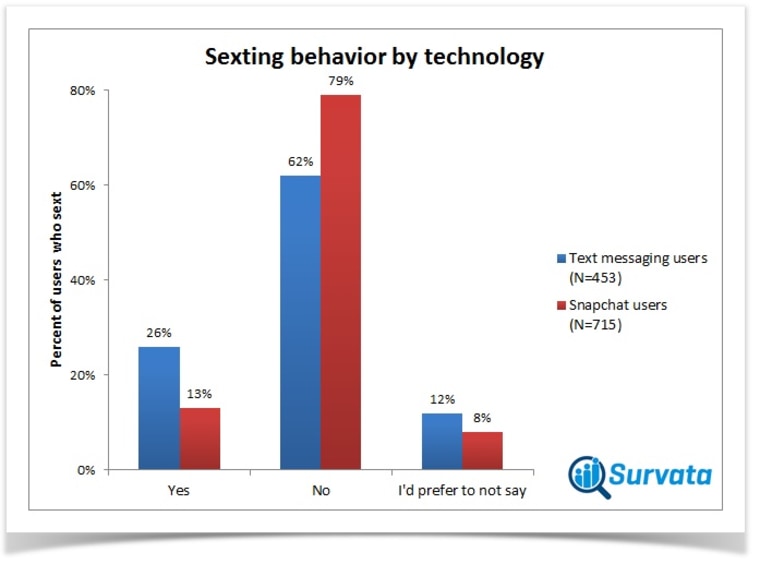
A service that lets you send images that self-destruct after 10 seconds? Why would parents freak out about that? While the initial furor over Snapchat — Young people will use this to sext! Young people don’t understand that nothing digital ever truly goes away! — has died down, an increasing number of kids are using the surprisingly addictive service.
“We send mostly embarrassing things,” Beth Hannon, a 21-year-old Indiana University student, explains, describing her own experience with Snapchat. “Pictures of myself or funny faces. People will send singing videos or videos of people dancing.”
Hannon is actually at the older end of the Snapchat user base. According to a January survey of over 1,000 people conducted by Survata, 13 percent of teens age 13 to 18 use the service, while just 4 percent of those age 19 to 25 do.
But the activity is growing like crazy. In April, Snapchat reported 150 million snaps per day, with billions of photos shared, up from just 20 million in October 2012.
A further Survata inquiry (consisting of over 5,000 people) suggests that it’s not sex that’s on the brains of these covert-messaging kids. While 26 percent of text messaging users say they get kinky using regular text messages, just 13 percent of Snapchat users fess up to sexting on the service.

“It’s just quick light-weight communication,” Danah Boyd, a senior researcher at Microsoft Research, whose research focuses on young people and social media, told NBC News.” For a lot of young people, they’re just throwing these images back and forth … because why keep them around?” Boyd said.
The biggest bonus of Snapchat seems to be … it’s not Facebook. “You post something on Facebook and mom flips out,” Boyd said, pointing out that younger people need a space of their own, for the times when “that photo was just supposed to be a joke” which parents would just not wrap their minds around.
Teens may keep Facebook profiles, but they have “waning enthusiasm” for the network, thanks largely to “increasing adult presence,” according to a new study by the Pew Research Center’s Internet & American Life Project. Instead, they turn to services like Snapchat to evade the parental units.
With Snapchat’s popularity on the rise, there is an increasing fuss over the fact that its central differentiator — the impermanence of the messages — just isn’t true.
A quick Google search reveals plenty of how-to guides and video walkthroughs that’ll help anyone save Snapchat photos and videos indefinitely, effectively circumventing the ten-second self-destruct feature. Even Snapchat co-founder and CEO Evan Spiegel said, during an interview with TODAY, “It’s actually really easy to capture and save Snapchat content […] and it’s really important for our users and the media to understand that, you know,” he said.
There is a bit of a safety net — though one with plenty of workarounds: When someone takes a screenshot of a message, the sender is notified. The screenshot notification has actually become, in some circles, a sign of appreciation. After the sender receives notice that a screenshot has been taken, the recipient deletes the screenshot.
If Snapchat sounds like a game, it’s because that’s what it really is.
Saving a picture would constitute a violation of accepted social behavior, said Boyd. “If I signal to you how to treat this piece of media,” most kids tend to treat it accordingly. When we asked Boyd about how teens feel when rules are broken and images are retrieved, she said teens don’t care. “Most of these pictures aren’t that heavy.”
Hannon’s main concern regarding captured messages is the ensuing awkwardness. “Sometimes you’re out and you’re sending them and then you forget what you sent and then someone took a screenshot and you don’t know what you sent.”
It’s not traumatizing — because these messages are just lighthearted silliness. “It’s mostly embarrassing,” Hannon said.
The consensus seems to be that Snapchat is a medium for silliness. Survata’s respondents said it’s for “silly faces,” “funny pictures” and “jokes.” A quick straw poll of my own Twitter, Facebook and Google+ followers reveals that those who use Snapchat — and not all do, as some consider it “uncool” — treat it as a way to send “random pictures” and to “draw things on them.”
“It’s just a quick laugh,” more than one person told me.
Want more tech news or interesting links? You’ll get plenty of both if you keep up with Rosa Golijan, the writer of this post, by following her on Twitter, subscribing to her Facebook posts, or circling her on Google+.
Source: here
